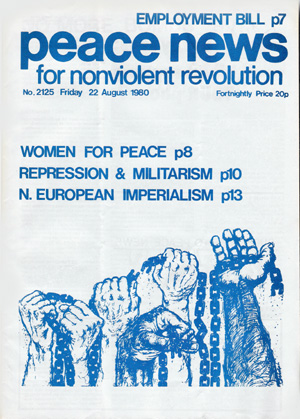Det danske Fredsakademi
Kronologi over fredssagen og international politik 6. september 1980 / Timeline September 6, 1980
Version 3.55. September 1980, 7. September 1980
 |
 |
09/06/1980
NO MORE BOMBS
Last year, in commemoration of the dropping of the Bomb on
Hiroshima, a writer lamented on the back cover of Peace News that
he would yet again be "one of a pitifully small group on a vigil in
a main street". This year, thousands of people all over the country
added their silence to the memory of the people who died and are
still dying from the effects of the Bomb. The following reports
convey the breadth of activlty that took place activity that
expressed itself as protest against the new generation of nuclear
weapons as well as the memory of 35 years ago.
GREENHAM COMMON
Meg reports: We held a 75 hour vigil outside the entrance to RAF
Greenham Common, to commemorate the bombings of Hiroshima and
Nagasaki, and to protest against the proposed use of this base as
home site for part of "our share" of Cruise Missiles. A camp was
set up on a small triangle of MoD grass beside the main entrance to
the base and the busy Newbury to Basingstoke road.
The vigil began at 8.13 am on Wednesday August 6 and continued
until 11.02 on Saturday August 9. We formed a circle at thirteen
minutes past the hour throughout the day and well into the night,
and sang songs, read and kept silence, and the vigil ended with a
two hour session of songs, readings and street theatre, followed by
a two minute silence and presentation of a cherry tree to the base
commander.
Attendance varied from over 200 in the final two hours to about 10
in the middle of Thursday morning. A cross-section of people came
whose ages ranged from late 70s to a babe in arms, and we were
joined by Danes, a Finn, Swiss, Italian and some North Americans.
The tone was set by the presence of large numbers of local Quakers,
several veterans of the peace movement and the Buddhist monks from
Milton Keynes. One monk fasted for the whole time and spent from
6am to 6pm chanting and beating his drum-accompanied by one of US-
a few yards from the guard house. We attracted support from
passers-by, some of whom stopped their journey to join us, and
hoots and thums-up signs particularly from longdistance lorry
drivers. There was also a steady stream of derision from other
drivers, but while I was there the positive support outweighed the
negative.
We made the TV news, local radio, and newspapers, so as a publicity
exercise the vigil can be seen as a success. For those of us who
attended, the experience was very positive and highly charged-the
atmosphere of the site changed-and gave us an opportunity to get to
know each other better. Negative criticisms came entirely from the
people who spent a short time at the vig il at the start and
finish, and predictably from members of the lefttendencies who were
alienated by the atmosphere. This feeling was shared by a group of
young army officers who came along to disrupt us af ter the pubs
closed. They shouted at us for half an hour and fled in terror when
we formed a silent circle.
For me it made a useful contrast to overtly political
demonstrations, without long speeches by big names, and it was good
to attend an event for peace together with groups of people I don't
normally meet, but who clearly have a great deal to offer. Contact:
Campaign Atom, tel Oxford 47429.
Kilde: Peace News for nonviolent revolution, nr.
2125, 22. august 1980, s. 3.
|
|
|